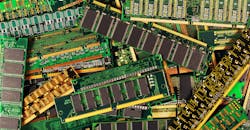One constant throughout the CPU multicore battles, the rise of GPGPUs, and FPGAs in the cloud is memory. It remains a key element of every system and is often found in many forms, from cache to DRAM to NAND flash. The latter garners the most attention these days at events like the Flash Memory Summit (FMS), where the latest storage technologies were out in force.
NAND flash continues to dominate the non-volatile (NV) mass-storage market in light of dramatically dropping prices for multi-layer QLC NAND. New interfaces like M.2, U.2, and SD Express are bringing higher throughput interfaces using PCI Express and NVMe, which are pushing SATA and SAS out of its entrenched areas close to the processor. SATA and SAS are managing ever-growing arrays, though.
One theme at FMS that stood out this year was persistent memory and its associated hardware, NVDIMMs. These DIMMs are on the same bus as DRAM, but with non-volatile memory that can range from NAND flash to Intel’s Optane. Putting this memory next to a processor increases throughput and reduces latency compared to even NVMe storage.
New memory technologies like MRAM and RRAM are playing in this space. Embedded MRAM is also getting more play, with the major foundries now supporting it. Many ASIC developers are using it, too, but don’t ask who. It tends to be the secret sauce that no one wants to talk about.
There are multiple challenges for these emerging memory technologies, with differences in price, availability, and capacity being major considerations when competing with NAND flash and DRAM. Objective Analysis’ Jim Handy notes, “Spot prices, a leading indicator of where contract prices are likely to head, have been on a steady decline through all of 2018. Objective Analysis expects this trend to continue with NAND flash, then migrate to DRAM, until prices reach cost, resulting in a profitless 2019 for memory chips. This will slow the migration to the new memory technologies profiled in our new report ‘Emerging Memories Poised to Explode.’”
Memory appetite among developers is insatiable. Likewise, memory hierarchies are becoming even more complex. For example, the memory bus may now have different DIMMs installed. Hard drives could be part of the mix, but they’re way out on the periphery where capacity and price trumps performance.
Still, memory technology is one area that continues to push the limits with long-term growth almost assured, especially when compared to CPUs and even GPUs that are frequency-challenged. Increasing and improving cores is great, but memory technologies lend themselves to this type of scalability as well.
As Bob Hope used to say, “Thanks for the memory.”
About the Author
William G. Wong
Senior Content Director - Electronic Design and Microwaves & RF
I am Editor of Electronic Design focusing on embedded, software, and systems. As Senior Content Director, I also manage Microwaves & RF and I work with a great team of editors to provide engineers, programmers, developers and technical managers with interesting and useful articles and videos on a regular basis. Check out our free newsletters to see the latest content.
You can send press releases for new products for possible coverage on the website. I am also interested in receiving contributed articles for publishing on our website. Use our template and send to me along with a signed release form.
Check out my blog, AltEmbedded on Electronic Design, as well as his latest articles on this site that are listed below.
You can visit my social media via these links:
- AltEmbedded on Electronic Design
- Bill Wong on Facebook
- @AltEmbedded on Twitter
- Bill Wong on LinkedIn
I earned a Bachelor of Electrical Engineering at the Georgia Institute of Technology and a Masters in Computer Science from Rutgers University. I still do a bit of programming using everything from C and C++ to Rust and Ada/SPARK. I do a bit of PHP programming for Drupal websites. I have posted a few Drupal modules.
I still get a hand on software and electronic hardware. Some of this can be found on our Kit Close-Up video series. You can also see me on many of our TechXchange Talk videos. I am interested in a range of projects from robotics to artificial intelligence.


